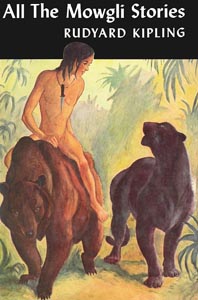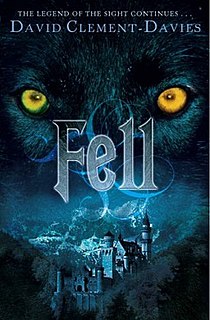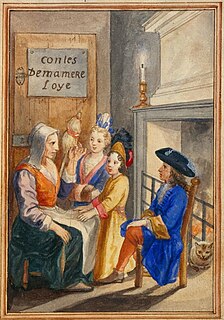 W
WAesop's Fables is a 2000 collection of 61 fables from the Aesop ouvre, retold by Jerry Pinkney. It includes stories about wolves, foxes, lions, dogs, mice, and donkeys.
 W
WAkela is a fictional character in Rudyard Kipling's stories, The Jungle Book (1894) and The Second Jungle Book (1895). He is the leader of the Seeonee pack of Indian wolves and presides over the pack's council meetings. It is at such a meeting that the pack adopts the lost child Mowgli and Akela becomes one of Mowgli's mentors.
 W
WAll the Mowgli Stories is a collection of short stories by Rudyard Kipling. As the title suggests, the book is a chronological compilation of the stories about Mowgli from The Jungle Book and The Second Jungle Book, together with "In the Rukh". The book also includes the epigrammatic poems added to the stories for their original book publication. All of the stories and poems had originally been published between 1893 and 1895.
 W
WThe Call of the Wolves is a 1989 children's picture book by Jim Murphy and illustrated by Mark Weatherby. It is about a young wolf that is separated from his pack during a caribou hunt but is eventually reunited.
 W
WChronicles of Ancient Darkness is a series of six historical fantasy novels by the British author Michelle Paver, her first books for children. The books chronicle the adventures of Torak, an adolescent boy, and his friends Renn and Wolf. The main story arc revolves around Torak and his quest to defeat the Soul Eaters, a group of power hungry mages who seek out to destroy all life in the forest. Paver has called it simply "a single story: the tale of Torak's discovery of himself and his world."
 W
WFell is a novel, written by David Clement-Davies as a follow-up to The Sight. The book was published in 2007 by Amulet Books. It follows the story of Fell, a wolf who left his pack after the events of The Sight.
 W
WMaugrim is a fictional character in the novel The Lion, the Witch and the Wardrobe by C. S. Lewis. A Narnian wolf, he is the Captain of the White Witch's Secret Police. In early American editions of the book, Lewis changed the name to Fenris Ulf, but when HarperCollins took over the books they took out Lewis' revisions, and the name Maugrim has been used in all editions since 1994.
 W
WThe Fox, the Wolf and the Husbandman is a poem by the 15th-century Scottish poet Robert Henryson and part of his collection of moral fables known as the Morall Fabillis of Esope the Phrygian. It is written in Middle Scots. As with the other tales in the collection, appended to it is a moralitas which elaborates on the moral that the fable is supposed to contain. However, the appropriateness of the moralitas for the tale itself has been questioned.
 W
WHistoires ou contes du temps passé, avec des moralités or Contes de ma mère l'Oye is a collection of literary fairy tales written by Charles Perrault, published in Paris in 1697. The work became popular because it was written at a time when fairy tales were fashionable amongst aristocrats in Parisian literary salons. Perrault wrote the work when he retired from court as secretary to Jean-Baptiste Colbert, minister to Louis XIV of France. Colbert's death may have forced Perrault's retirement, at which point he turned to writing. Scholars have debated as to the origin of his tales and whether they are original literary fairy tales modified from commonly known stories, or based on stories written by earlier medieval writers such as Boccaccio.
 W
WJulie is a children's novel by Jean Craighead George, published in 1994, about a young Iñupiaq girl experiencing the changes forced upon her culture from outside. It is the second book in a trilogy by George, after Julie of the Wolves (1973) and before Julie's Wolf Pack (1997).
 W
WJulie of the Wolves is a children's novel by Jean Craighead George, published by Harper in 1972 with illustrations by John Schoenherr. Set on the Alaska North Slope, it features a young Inuk girl experiencing the changes forced upon her culture from outside. George wrote two sequels that were originally illustrated by Wendell Minor: Julie (1994), which starts 10 minutes after the first book ends, and Julie's Wolf Pack (1997), which is told from the viewpoint of the wolves.
 W
WJulie's Wolf Pack is a 1997 novel written by Jean Craighead George. It is the second sequel to the Newbery Medal winner Julie of the Wolves after Julie, and the last in the Julie of the Wolves trilogy. It is the only book in the series whose story is told from the viewpoint of the wolves themselves, rather than from Julie's point of view.
 W
WLittle Red Riding Hood is a 2007 children's picture book of the Brothers Grimm classic fairy tale adapted by Jerry Pinkney.
 W
WMaugrim is a fictional character in the novel The Lion, the Witch and the Wardrobe by C. S. Lewis. A Narnian wolf, he is the Captain of the White Witch's Secret Police. In early American editions of the book, Lewis changed the name to Fenris Ulf, but when HarperCollins took over the books they took out Lewis' revisions, and the name Maugrim has been used in all editions since 1994.
 W
WMisha: A Mémoire of the Holocaust Years is a literary hoax by Misha Defonseca, first published in 1997. The book was fraudulently published as a memoir telling the supposed true story of how the author survived the Holocaust as a young Jewish girl, wandering Europe searching for her deported parents. The book sold well in several countries and was made into a movie, Survivre avec les loups, named after the claim that Misha was adopted by a pack of wolves during her journey who protected her.
 W
WNever Cry Wolf is an account of the author's experience observing wolves in subarctic Canada by Farley Mowat, first published in 1963 by McClelland and Stewart. It was adapted into a film of the same name in 1983. It has been credited for dramatically changing the public image of the wolf to a more positive one.
 W
WRaksha is a fictional character featured in Rudyard Kipling's Mowgli stories, collected in The Jungle Book and The Second Jungle Book.
 W
WRunt is a 2002 children's novel written by Marion Dane Bauer. It tells of a story about a wolf pup who is a runt.
 W
WThe Sight is a novel written by David Clement-Davies about a pack of wolves. The pack members are: Huttser, Palla, Khaz, Kipcha, Brassa, Bran, Larka and Fell in addition to Kar and Skop, Palla's brother and Kar's companion, who join later in the book.
 W
WThe Morall Fabillis of Esope the Phrygian is a work of Northern Renaissance literature composed in Middle Scots by the fifteenth century Scottish makar, Robert Henryson. It is a cycle of thirteen connected narrative poems based on fables from the European tradition. The drama of the cycle exploits a set of complex moral dilemmas through the figure of animals representing a full range of human psychology. As the work progresses, the stories and situations become increasingly dark.
 W
WThe Three Little Wolves and the Big Bad Pig is a children's picture book written by Eugene Trivizas, illustrated by Helen Oxenbury, and first published by Heinemann in 1993. The story is a comically inverted version of the classic Three Little Pigs, a traditional fable published in the 19th century.
 W
WWhite Fang is a novel by American author Jack London (1876–1916) — and the name of the book's eponymous character, a wild wolfdog. First serialized in Outing magazine, it was published in 1906. The story details White Fang's journey to domestication in Yukon Territory and the Northwest Territories during the 1890s Klondike Gold Rush. It is a companion novel to London's best-known work, The Call of the Wild (1903), which is about a kidnapped, domesticated dog embracing his wild ancestry to survive and thrive in the wild.